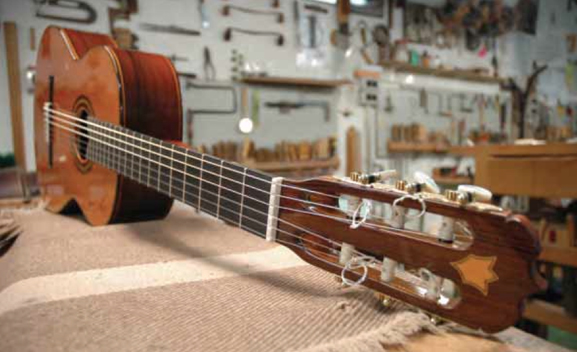Sculpted Sound
Since the establishment of the present shop, each successive generation of the Ramírez family has further explored the nuances of the classical guitar’s functional and formal elements—more specifically, the sonorous qualities of various woods, the shaping of an instrument’s body to enable effective projection of the notes over longer distances, and the art of beautiful finishing. As a result, Ramírez guitars have become the zenith of craftsmanship to which all other guitar makers aspire.
 Today, presiding head of the family Amalia Ramírez runs the show. Like her ancestors before her, Ramírez still personally supervises the construction process of all new instruments, which are produced at a rate of around four guitars per month. Carmelo Llerena has worked in this building all his life, beginning at 14 in 1971 when he was introduced to the workshop on sweeping duty. He has now attained the status of journeyman in the shop’s Renaissance-style artisan path.
Today, presiding head of the family Amalia Ramírez runs the show. Like her ancestors before her, Ramírez still personally supervises the construction process of all new instruments, which are produced at a rate of around four guitars per month. Carmelo Llerena has worked in this building all his life, beginning at 14 in 1971 when he was introduced to the workshop on sweeping duty. He has now attained the status of journeyman in the shop’s Renaissance-style artisan path.
Although their guitars are known the world over, the Ramírez family’s supreme artistic achievement is perhaps the acceptance of one of its creations into the permanent collection of New York’s Metropolitan Museum of Art.A guitar created by the talented hands of Manuel Ramírez in the early part of the 20th century and once owned by one of the world’s finest guitarists, Andrés Segovia, has called the Met its home since 1986, when Segovia’s wife, Emilita, presented the guitar to the museum shortly before her husband’s death.
As the story goes, the Met’s guitar made its way into Segovia’s hands in 1916 when the precocious young guitar player boldly approached and asked Ramírez point blank if he could borrow a guitar for a concert.The then- unknown Segovia proceeded to try out one of the guitars in the workshop, producing an impromptu recital that so impressed the guitar maker he simply handed over the six-stringer to the talented young musician. Segovia went on to use the guitar in concerts throughout the rest of his long career.
“In his tenacious pursuit of his lifelong goal, José Ramírez III has built the most sonorous and beautifully-timbered guitars in the whole world,” Segovia himself attested.The famed guitarist made clear before passing that his guitar would live on at the museum as a display piece, never to be played again; his wishes have been fulfilled.
And the genuine Ramírez craftsmanship that Segovia so admired continues to this day in the construction of the popular Anniversary model, commemorating 125 years of Ramírez excellence. Every one of the Anniversary guitars made has a unique and different detail inlaid into the headstock.
With a top of red cedar, back and sides of Madagascar rosewood and a Cameroon ebony fingerboard, the Anniversary contains machine heads that are hand engraved in a pattern unique to each guitar. The edging around the main body of the guitar (the so-called purfling) is done in Cuban mahogany and the “filleting” is applied around the rim of the sound hole. A signature box- wood adornment accentuates the headstock and carvings on the extremity of the bridge serve as a testament to the artistry of the craftsmen behind this true Stradivarius of guitars.
Image: Manuel Ramirez, Classical Guitar, 1912.Wood. Image courtesy Ramírez Guitars/The Metropolitan Museum of Art.
Photos by Mar del Amo Pimentel


